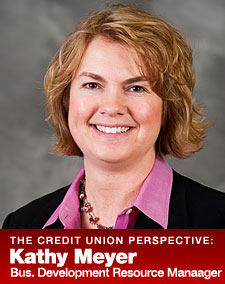 Credit unions have long been known for their member service-oriented cultures. Typically, cross-selling was something credit unions waited for their members to cue them on before taking action. Because of this, credit unions have often been labeled as meager cross-sellers, especially when compared to their banking counterparts.
Credit unions have long been known for their member service-oriented cultures. Typically, cross-selling was something credit unions waited for their members to cue them on before taking action. Because of this, credit unions have often been labeled as meager cross-sellers, especially when compared to their banking counterparts.
It’s no secret that the competitive landscape has changed in the past 10 years or so for credit unions. So too has the need to become more assertive on the cross-sell front. Now, more than ever, as credit unions and banks fight to organically expand relationships with their members and customers to gain a larger share of wallet and loyalty, cross-selling is taking a front seat.
Credit unions as a whole have taken great strides in the area of cross-selling. They are doing a much better job of presenting themselves as the complete consumer financial package, and they’re growing membership because of it.
Traditionally, sales-heavy focused banks could stand a chance to pick-up on some finer points of cross-selling from credit unions. Rather than assaulting customers with extreme staff sales goals and complex software packages that identify every pocket of opportunity, banks should use these three tips to build a better relationship with their customers.
More: What Banks And CUs Can Learn From One Another About Content Marketing

The Financial Brand Forum Kicks Off May 20th
Explore the big ideas, new innovations and latest trends reshaping banking at The Financial Brand Forum. Will you be there? Don't get left behind.
Read More about The Financial Brand Forum Kicks Off May 20th

Navigating Credit Card Issuing in an Uncertain Economic Environment
Build a modern credit card strategy that balances profitability and risk, adopts the latest technology and delivers the customization that cardholders demand.
Read More about Navigating Credit Card Issuing in an Uncertain Economic Environment
1. There should always be a win-win-win. A cross-sale does no one any good if the customer figures out, a month down the road (or worse, sooner), that the product or service sold to them is of no use or creates a new fee. Cross-sales need to benefit the customer, the bank and the sales representative to be effective and help the financial. Loyalty will be won in valuable cross-sold services.
2. Know where the line is. There are numerous, negative stories of bank customers walking into branches, calling the bank or logging in to online banking and being presented with a cross-sale opportunity–every single time. Perhaps even for the same product. Even Walmart’s former CEO complained about this practice. Use your cross-sell software to scale back the number of times each customer is targeted for a cross-sell. If you emphasize everything, you emphasize nothing. Customers become accustomed to just saying no. Check out this funny parody that The Financial Brand found back in 2009.
3. Keep it interesting. We’re not talking about going out of your way to spruce up your existing product and service line. But, there is something to be said about keeping the conversation interesting. Take a look at your cross-sell scripts for employees. Try some interesting conversation tactics to draw in your customers and personalize the pitch.
The Art of Bank Cross-Selling: Think Sticky, Hyper-Targeting and Goal-Setting
 Cross-selling in the banking industry proved to be a way of life early on for many financials. Banks have traditionally had a broad array of products and services to offer their customers and were able to easily market packaged products and relationship score programs to encourage cross-selling. Additionally, banks have succeeded in being able to show their customers the value of maintaining a strong relationship.
Cross-selling in the banking industry proved to be a way of life early on for many financials. Banks have traditionally had a broad array of products and services to offer their customers and were able to easily market packaged products and relationship score programs to encourage cross-selling. Additionally, banks have succeeded in being able to show their customers the value of maintaining a strong relationship.
Banks have also excelled in the arena of pioneering and using rigorous programs to ramp up cross-sale efforts. These include utilizing advanced software programs and implementing systematic staff training and goal setting. From day one in many large banks, it is clear to a branch staff member what their cross-sell goals will be. Advanced cross-sell software programs help banks find pockets of opportunity that may not otherwise be obvious to the cross-seller.
Banks, along with their credit union counterparts, have become more and more drawn to cross-selling as a way of increasing the financial institution’s bottom-line results. Many banks draw a quick line between gaining an increased share of a customer’s wallet and a healthier balance sheet. Additionally, the more a bank can acquire loyalty by customers using them as their primary financial institution, the less that bank needs to worry about attrition.
Credit unions have often waited in the wings when it comes to taking the next step in cross-selling to their members. Instead of taking the next great leap on their own, many credit unions have waited for banks to perfect a cross-selling system before transposing for their own use. Credit unions should use these three tips to help beef up their cross-sell programs to improve their results.
Read More: What Banks And CUs Can Learn From One Another About Lending
1. Know your sticky products. A cross-sale becomes valuable to the financial institution when it does one of two things: generates more income for the financial or builds a more loyal relationship with the customer. Know and understand which of your products will offer the most impact–and hone in on cross-selling these products. Cross-selling e-statements is a nice convenience for the customer (and certainly can decrease operational costs), but it doesn’t do much in the way of either income or customer loyalty.
2. Hyper-target marketing is key. At its heart and soul, cross-selling is all about target marketing. Your cross-sell software platform is designed to target opportunities with your members. However, it’s time to take the target marketing to the next level. Dig into your member data and find opportunities beyond asking for a checking account where there is none.
Analyze the transaction data of your customers. Import your member’s credit data, if available. Better yet, use your MCIF data and append it to the credit data—and use it to build personas and message maps that help you understand the propensity of specific segments of your membership. You’ll be better suited for what you sell to whom. At the end of the day, it’s about finding pockets of opportunity that make your financial unique and setting up your cross-sell system to hyper-target them.
Xceed Financial Credit Union’s CMO summed it up perfectly when asked about what marketers need to do to be successful in 2014: “Know your target audience better than ever …”
3. Your staff needs to know what their goals are. If you walked into one of your branches or your call center and asked a staff member how many cross-sells they had today, and how many more they needed to meet their daily or weekly goal, would they know the answer? Being clear with staff about their cross-sell goals is a great step toward building a successful cross-sell program—and ultimately stronger customer relationships.







